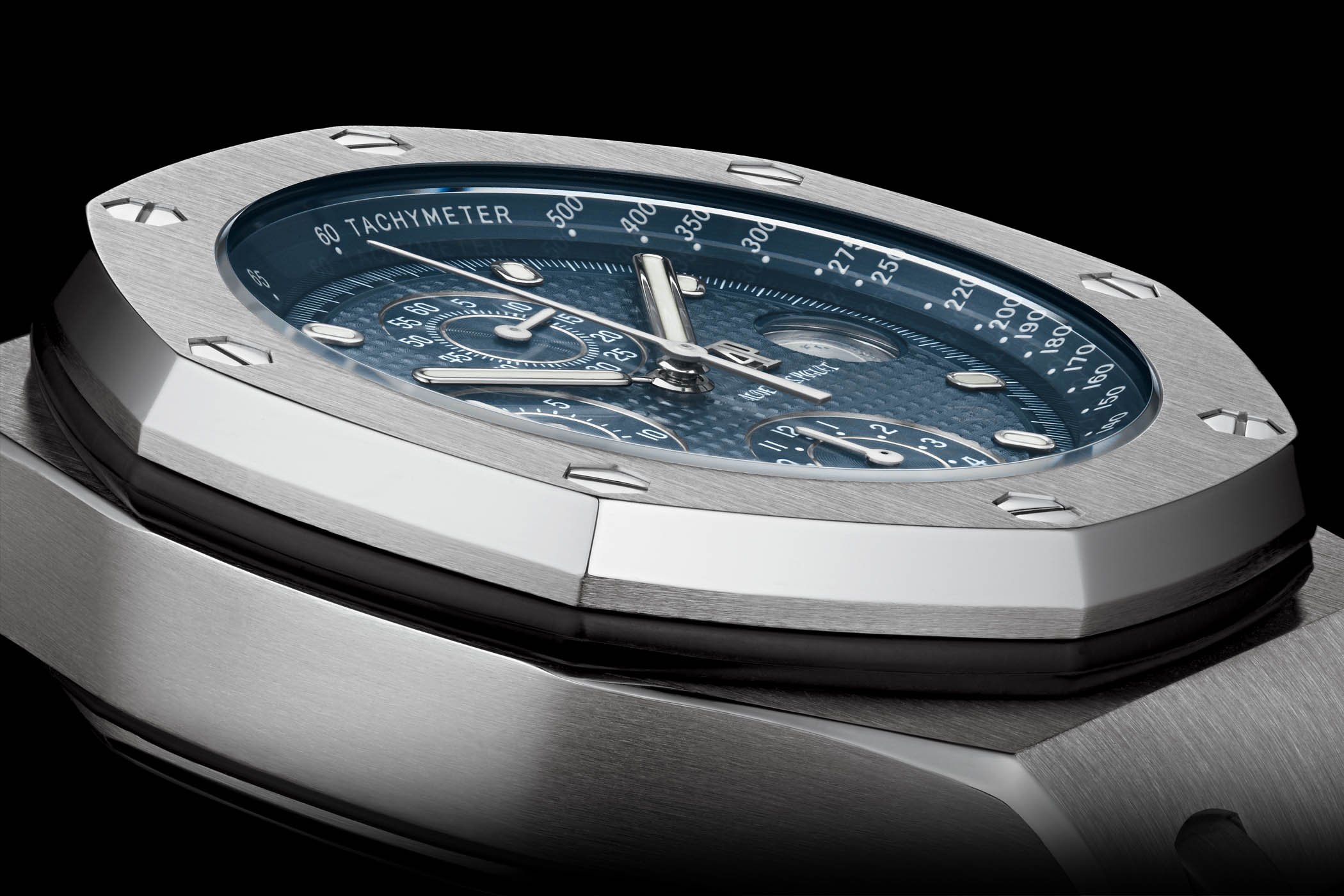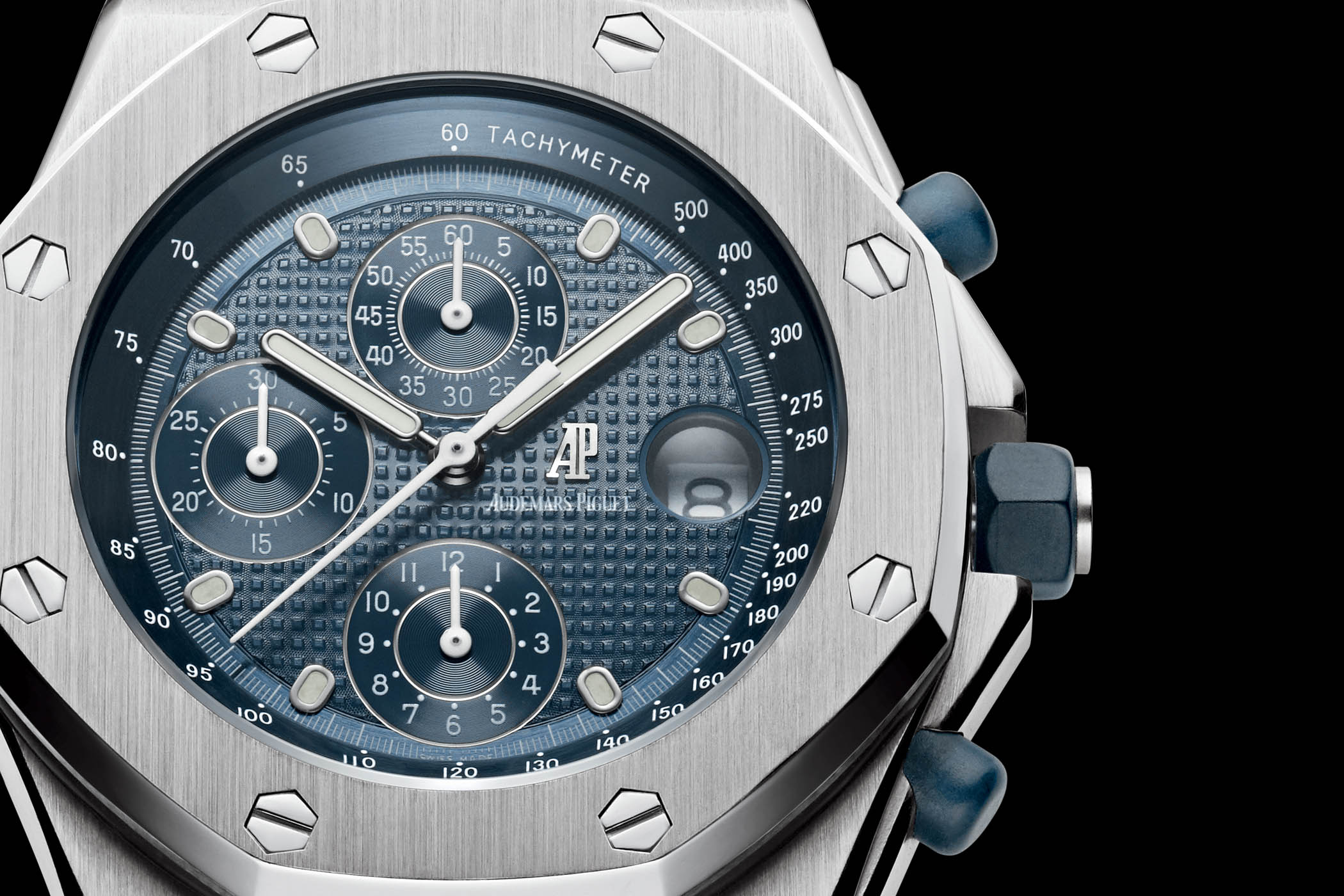Audemars Piguet Royal Oak Offshore Selfwinding Chronograph 44mm Smoked Dials
The brazen looks of the latest ROO chronographs.

The Royal Oak Offshore has always been considered a watch for men who are not afraid of making a (big) statement. And it’s not just size we’re referring to here but the aura of virility and strength transmitted by the dynamic architecture of the watch. In June 2020, the brand from Le Brassus introduced three new Royal Oak Offshore 44mm chronographs in black ceramic cases with bold contrasting materials accentuating its solid, angular architecture. Nothing radically new in that field since models with ceramic cases and other materials have been the mainstay of this ROO 44mm collection. The real novelties of the trilogy were the incorporation of XXL Arabic numerals and smoked dials, a big trend in watchmaking today. For this hands-on session, we had the bold black and blue ceramic model and the luxurious black ceramic and 18k pink gold version.
From RO to ROO
Launched at baselworld 1993, just after the 20th anniversary of the iconic Royal Oak – the iconic Gerald Genta creation that defined the concept of the luxury sports watch – the Royal Oak Offshore was as daring and defiant a proposal as the Royal Oak had been in 1972. The ROO was an oversized, high-testosterone version of the Royal Oak, a colossal 42mm watch (huge dimensions in 1993) bristling with textures and bold combinations of materials.

As an offshoot of Genta’s iconic Royal Oak, the ROO paid homage to the legend with hallmark design features like the raised octagonal bezel and exposed screws, the guilloché tapisserie dial, the integrated bracelet and the overall industrial design mood. However, the ROO was beefier and bolder than the RO and rigged with materials that were not associated with high-end watchmaking. Beyond its enormous proportions, what shocked many conservative watch lovers was the daring “deconstructed” exposure of the black rubber gasket between the case and the bezel.
Not only that, but rubber was also used for the chronograph pushers and the crown. This might seem conventional practice these days, but back then it was radical. Making its debut at Baselworld 1993, the 250-gram steel chronograph (Ref. 25721 ST) quickly earned the nickname “The Beast” and was met with radically divided opinions. For the 25th anniversary of the ROO, the brand revisited the chronograph version (Ref. 26237ST) and an over-the-top openworked anniversary ROO tourbillon chronograph.
Taming “The Beast”
All three chronographs that appeared in summer 2020 share the same 44mm x 14.4mm brushed black ceramic case and the distinctive lateral module that protects the crown and houses the rectangular chronograph pushers. The two models we got to spend time with are the black ceramic base/18k pink gold and the black ceramic base/blue ceramic accents – the third model has a green dial and a green ceramic bezel and accents. As a brand that does not shy away from colour, Audemars Piguet exploits bold contrasts to highlight the prominent architecture of the ROO Chronograph. You can appreciate how contrasting finishes and contrasting colours underscore the dynamic architecture of the case.
The black ceramic case features a vertical-brushed surface with refined, polished bevels. Both the blue ceramic and the 18k rose gold bezels follow suit and are decorated with a vertical-brushed finish drawing the eye downward to elongate the formidable dimensions of the watch. Even the hexagonal steel screws on the octagonal bezel are aligned for a tighter, more compact look. The screw-locked crown guards are also brushed vertically as is the blue or black hexagonal ceramic crown. The sleek rectangular push-piece guards (in titanium or pink gold, depending on model) housing the chronograph pushers are sandblasted/frosted and brushed on the underside.
The imposing architecture of the 100m water-resistant case and the high level of finishes are what make this model so intriguing. Design touches like the integrated blue or black textured rubber strap, with its two indented channels tapering from the lugs, go a long way in reducing the overall bulk and elongating the lines.
Bigger numbers
As mentioned, the novelties of these chronographs are the use of large applied Arabic indices and gradient dials. The applied baton-style hour markers appearing on other versions of the ROO Chronograph have been supplanted by the new Arabic numerals made in gold, applied to the dial and filled with white lume. Noticeably thicker baton-style markers have been preserved at 12, 3, 6 and 9 o’clock to accommodate the three sub-dials and date window. Running seconds are placed at 12, the 30-minute elapsed time counter at 9, the 12-hour counter at 6, and a round date window at 3 o’clock.
Both the sub-counters for the chronograph indications are a rhodium colour. It’s curious, but a round date window in this context is far less invasive than a rectangular aperture, and its black background matches the background of the small seconds. The classic Royal Oak hands have not become thicker and are still made from gold and treated with lume while the central seconds hand has a black lacquered tip.
Let’s not forget that there is also a tachymeter scale on the flange, so available space on the dial is limited. Given their large dimensions, the Arabic numerals make the dial busier and butcher, but the payoff is enhanced legibility. The hallmark “Mega Tapisserie” pattern of the ROO family is still here but has now been treated to a gradient/fumé effect transiting from a lighter colour (blue or grey) in the centre to a darker colour on the periphery of the dial.
Automatic movement
AP relies on its self-winding calibre 3126/3840, a modular movement (with Dubois Depraz chronograph mechanism) that powers practically every modern ROO chronograph (42mm and 44mm) since 2007. These larger 44mm models replace the 22k gold rotor with a skeletonised blackened rotor with the AP logo. The movement has a diameter of 20.92mm, 59 jewels and a frequency of 21,600vph offering a power reserve of 50 hours. Although not many of the movement parts can be appreciated from the caseback, the finishes are contemporary.
Price
The blue Royal Oak Offshore Selfwinding Chronograph retails for EUR 37,900, the black ceramic and pink gold model for EUR 46,600. All three versions are boutique exclusive editions, available now.
More details at www.audemarspiguet.com.















1 response
A DD module on top for 40k ….I don’t think so . Don’t care how nicely finished it is but that is just ridiculous and the watch is too big anyways .